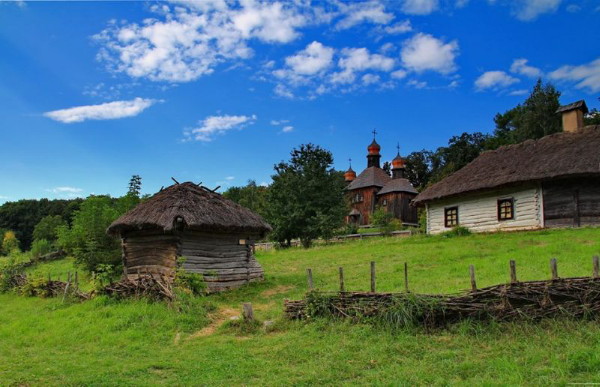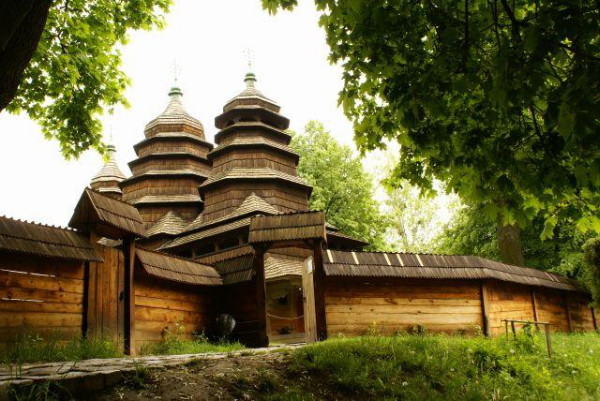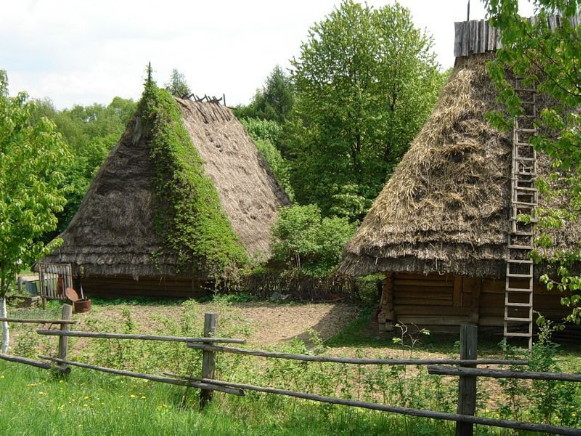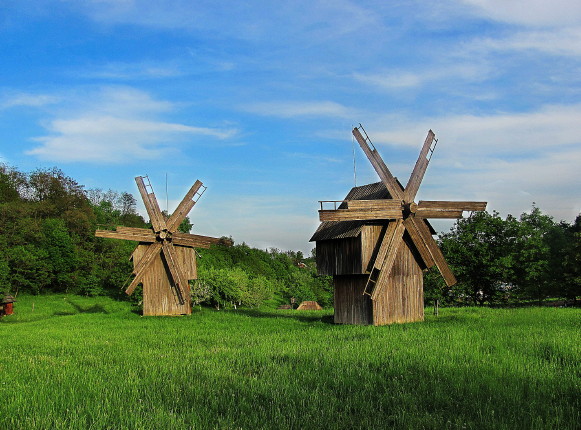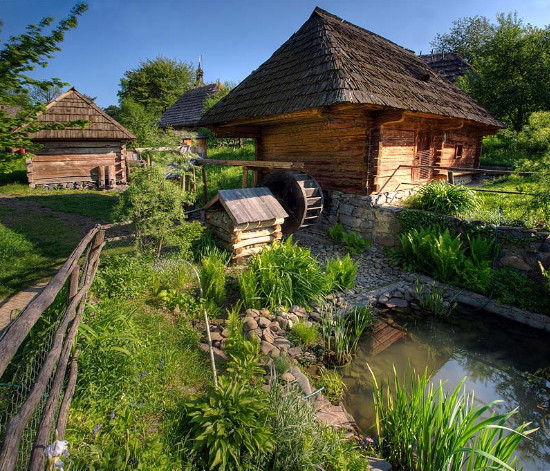Museums of folk architecture and folkways
Museums of folk architecture and folkways [Музеї народної архітектури і побуту; Muzeï narodnoï arkhitektury i pobutu]. The name of skansens or open-air museums in Ukraine. Open-air museums were introduced in Sweden in 1891 as offering an effective way of preserving folk architecture. By 1982, they had spread from there, and numbered more than 2,000 in Europe alone. In Ukraine there are 5 central and over 20 local and regional open-air museums. Most of them were built in the 1970s and 1980s on the model of foreign museums. Considered an important educational source, they are state-supported. Ukrainian open-air museums are devoted mostly to peasant cottages, with their furnishings and farm buildings, from the 19th and early 20th century. The ‘class’ differentiation within the prerevolutionary village in Ukraine was stressed in the displays. Churches, bell towers, schools, artisans' workshops, mills, and related structures occupy an important place in the museums. Virtually all of the buildings are original; replicas or reconstructions are the exception. The farms are stocked with livestock and fowl, and fields are planted with the local grains and vegetables. Trees and wild plants typical of the region are maintained.
Women in regional folk dress take care of the artifacts on display, and craftsmen, such as weavers, smiths, potters, and shingle makers, demonstrate old techniques in the workshops. These activities convey an impression of daily life. The museums often host concerts, festivals, souvenir markets, and thematic exhibits. They also have designated rest and recreation areas.
The largest museum of folk architecture and folkways in the former USSR is in Kyiv. When completed, it will be the largest such museum in the world. Its construction began in 1971 on a 150-ha site in a forest and park zone of the Pyrohiv district near the Exhibition of Economic Achievements of the Ukrainian SSR. By the summer of 1976 the first part had been opened to visitors. By 1985 the museum included 250 buildings and about 50,000 artifacts, such as costumes, woven products, implements, ceramics and wooden objects, and over 700 folk musical instruments. The museum site is divided into seven zones that correspond to the architectural-ethnographic regions of Ukraine at the beginning of the 20th century: the Middle-Dnipro River region, the Poltava region, Slobidska Ukraine, Polisia, Podilia, the Carpathian Mountains region, and southern Ukraine. In each zone a typical village was reconstructed; the Middle Dnipro village, for example, is laid out along a main road with a central square, the Polisian village is scattered unevenly around a main road, and the Carpathian village is a set of unconnected farmsteads. The church is the dominant building in almost every zone. Some rare old churches have been moved here: Saint Michael's Church (built in 1612) from Dorohynka, Kyiv region; one built in 1742 from Zarubyntsi, Cherkasy region; a 17th-century church from Kysorychi, Volhynia; a Podilian church from Zelene (1817); and a Transcarpathian church from Ploske (1742). A group of windmills is assembled in a separate area.
In 1979 an eight-zone (12-ha) site was opened devoted to the socialist village, later reorganized into a contemporary village complex. It exhibits the typical buildings of contemporary farms in Ukraine and is divided into six architectural-ethnographic regions: Polisia, the western forest-steppe, the eastern forest-steppe, the central forest-steppe, the steppe, and the Carpathian Mountains. Each subzone contains one or two farms and four or five buildings typical of the region. The farm cottages are furnished with contemporary, often factory-made, furniture, homemade articles, and folk handicrafts (embroidery, weaving, ceramics, engraved or embossed wooden articles, and painted artifacts). There are also religious items. In the future an archeological department, a prerevolutionary rural settlement, restoration and souvenir workshops, and an administrative and scientific building are to be added to the museum.
The Lviv Museum of Folk Architecture and Folkways occupies 67 ha of the Shevchenko Park. The idea of an open-air museum in Lviv was proposed first by Ilarion Svientsitsky in the 1930s, but only one wooden church (built in 1763) was moved to the site, from Kryvka near Turka. The church now serves as the museum's centerpiece. Construction of the skansen began in 1967, and the first part of its exhibition was opened in 1972. The original plan was to relocate 150 buildings, excluding minor structures, at the site. By 1980, 74 buildings had been moved and over 10,000 artifacts assembled at the museum. The Lviv open-air museum presents the folk architecture of Western Ukraine. Its territory is divided into eight historical-ethnographic zones: the Boiko region, the Hutsul region, the Lemko region, the Lviv region, Podilia, Polisia, Bukovyna, and Volhynia, and one area represents the old town. Each zone includes 15 to 20 buildings which constitute a distinctive miniature village.
The more outstanding stuctures in the Lviv open-air museum are a church (built in 1778) from Sokoliv, Ternopil region; Saint Michael's Church (1863), with a belfry from Tysovets, Lviv region; the Church of the Holy Trinity (1774), with a belfry from Chernivtsi; a chapel (1752) from Yalynkuvate; a belfry (1887) from Komarivka, near Brody; a school (1880) from Busovysko; a Lemko cottage from Zaricheve, in Transcarpathia; a Hutsul grazhda from Kryvorivnia; a chicken coop (1860) from Oriavchyk; an oil press (1811) from Holovetske, a water mill from Lybokhora; windmills from Shyrivtsi (Bukovyna) and Pidsynivka (Volhynia); a felt press from Pylypets, in Transcarpathia; smithies from Turie (1870) and Krasnoiliv; a Boiko sawmill from Velykosillia; Hutsul beehives from Kuzmynets and Zamahoriv; a shepherd's shed from Krynychna meadow; and a granary (1880s) from Pidlyssia.
Construction of the Pereiaslav-Khmelnytskyi Museum of Folk Architecture and Folkways began in 1965 on Tatar Hill, within the city. By 1980 it contained 140 structures from various oblasts, spread over a 30-ha site. The archeological department has preserved or reconstructed some ancient buildings, such as a house from the 11th century and the Cherniakhiv culture, a 10th-century pottery oven, wooden frame walls from 10th-century Kyiv, a square and pagan altar from the Trypillia culture period, and an early-14th-century house. There is also a wooden Cossack church (built in the 17th century) from Ostriiky, Bila Tserkva raion, a church from Andrushi (1767), and one from Viunyshche (1833), in Pereiaslav raion.
The collection consists of several peasant cottages of the 19th century, representing the landless, middle, and wealthy peasantry, and the houses of rural crafsmen (potter, oil maker, carpenter, weaver, tanner, cooper, and miller). The museum also has a collection of 14 windmills, 2 water mills, a parish school, a rural tavern, a community granary, a drying house, a village council hall with a jail, a large (8-ton) oil press, a hunting lodge, an arbor, and the upper structures of wells. In late 1982 a beekeeping museum based on F. Khvostyk's apiary in Pomokli, near Pereiaslav, was added. It is the only museum of its kind in Ukraine.
The Transcarpathian Museum of Folk Architecture and Folkways in Uzhhorod was established in 1965 and opened in 1970 on the slopes of Zamkova Hill. The relatively small site (3.5 ha) includes 13 rural houses, a grazhda, water mill, smithy, sawmill, felt press, lumbermen's cabin, shepherd's shed, tavern, schoolhouse, and beehives. Saint Michael's Church, from Shelestove (18th century), hovers over the village. One-half of the exhibition is devoted to the folk architecture of the Transcarpathian lowlands (Ukrainian, Romanian, Hungarian), and the other half to the buildings of the Transcarpathian highlands (Boiko and Hutsul).
The Chernivtsi Museum of Folk Architecture and Folkways was opened in 1983 in the tourist area, not far from the city center. It contains monuments of Bukovynian folk architecture.
A network of smaller local museums based on the Uzhhorod open-air museum was established in Transcarpathia. They consist of houses, churches, belfries, and sometimes farm or industrial buildings which have been preserved in their original locations or have been moved to a different place within their villages. Ethnographic museums housed in single cottages were formed in Antonivka, Buklyve, Horyncheve, Neresnytsia, Osii, Ternove, Vilnytsia, and Zubivka. There is an interesting milling complex in Monastyrets and a restored wooden dam (of the mid-19th century) and a log-driving, lumbering museum on the Chorna River, near Synevyr Lake. The wooden churches in Steblivka (built in 1780), Krainykove (1688), Danylove (1709), Neresnytsia (1798), Oleksandrivka (17th century), and Sokyrnytsia (18th century) have been converted into museums. A few wooden churches from Ukrainian villages in Transcarpathia were transferred to Czechoslovakia in the interwar period. In Bronka and Dovhe peasant cottages have been reconstructed and turned into museums; in Petrove a whole complex of old rural buildings has been erected.
In the late 1970s or early 1980s regional museums of folk architecture and folkways were built in Kamianets-Podilskyi (representing Podilia), Kharkiv (Slobidska Ukraine), Lutsk (western Polisia), Chernihiv (eastern Polisia), and Korosten (central Polisia).
Artifacts of Ukrainian folk architecture have been preserved in museums outside the country, in Czechoslovakia, Poland, Romania, and Canada. In 1975 construction of an open-air exhibition at Svydnyk, the Svydnyk Museum of Ukrainian Culture, was started. The first section (10 structures) was opened in 1981. The 7-ha site will include 45 buildings from Ukrainian villages in the Prešov region.
In 1963 an open-air museum was set up in Bardejovské Kúpele. It has over 30 buildings, virtually all of them from Ukrainian villages of the Prešov region. In 1977 construction of similar museums began in Stará L’ubovňa and Humenne. Most of the buildings in them are Ukrainian. A few Ukrainian peasant houses and farm buildings are part of the Slovak Village Museum in Martin. Some 27 wooden churches in the Prešov region were designated national monuments of Slovakia in 1968, and in 1979 the easternmost Ukrainian village, Osturňa, with its 236 houses and 1,100 inhabitants, was declared a state reservation of folk architecture.
The Sianik Museum of Folk Architecture contains the largest number of Ukrainian buildings in Poland. It was opened in 1968 and is now the largest Polish museum of its kind (over 100 structures). It includes a church from Grąziowa (1730), many Lemko and Boiko houses and farm buildings, and a large collection of Ukrainian icons and ethnographic materials. Much attention is devoted to the Ukrainian exhibits in the museum's official publications, Materiały Muzeum budownictwa ludowego w Sanoku and Acta scansenologica. Ukrainian folk architecture can be found also in the Ethnographic Park in Nowy Sącz, the Folk Building Center in Szembark, and other museums. A museum of Lemko culture was opened in Zyndranowe in the 1960s.
Romanian open-air museums, such as the Muzeul Satului in Bucharest and similar museums in Suceava, Tulcea, and Sighetul Marmaţiei, have holdings from Ukrainian villages.
In 1975 the Ukrainian Cultural Heritage Village near Edmonton was set up. Sponsored by the provincial government of Alberta, it includes pioneer artifacts and buildings and features re-enactments of daily life in rural Alberta before 1930.
BIBLIOGRAPHY
Materiały Muzeum budownictwa ludowego w Sanoku, no. 24 (1978)
Danyliuk, A.; Krasovs’kyi I.; Rybak, B.; Ianov, V. Muzei narodnoï arkhitektury i pobutu u L’vovi: Putivnyk (Lviv 1980)
Hudchenko, Z. Muzeï narodnoï arkhitektury Ukraïny (Kyiv 1981)
Czajkowski, J. Muzea na wolnym powietrzu w Europie (Rzeszów–Sanok 1984)
Bairak, Ia.; Fedaka, P. Zakarpats’kyi muzei narodnoï arkhitektury i pobutu (Uzhhorod 1986)
Mykola Mushynka
[This article originally appeared in the Encyclopedia of Ukraine, vol. 3 (1993).]
